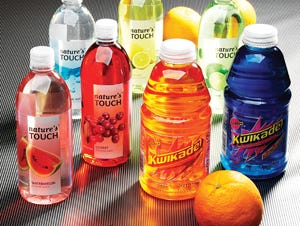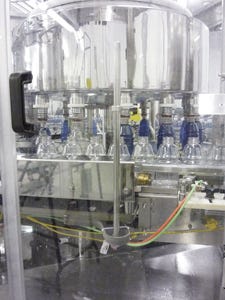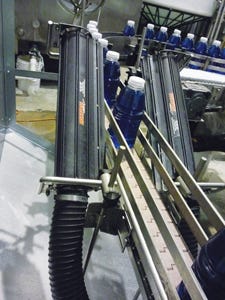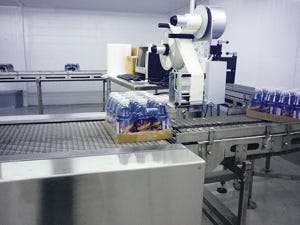Bottling line opens fresh opportunities for Kwik Trip
January 30, 2014
|
The approximately 335 Kwik Trip, Inc. convenience stores throughout Iowa, Minnesota and Wisconsin are part of a retail genre that serves as the modern version of the “neighborhood grocery,” and neighborhood shopping currently is enjoying a resurgence in popularity. In an article published on August 9, 2008 in the Washington Post, journalist Ylan Q. Mui notes, “convenience and drug stores are siphoning away sales from traditional supermarkets as the weak economy and high gas prices force consumers to save more by driving less.”
This high cost of gas, which has flirted with and in some parts of the country exceeded the $4/gal price-mark, also has brought up the value of Kwik Trip's 4 million gal of gasoline that is stored in the ground daily. The company maximizes the value of this approximately $16 million of buried treasure by vertically integrating its fuel operations. A subsidiary of the company – Convenience Transportation LLC – moves the fuel from pipeline to pump. This enables the parent company to keep more of profits within the organization. Convenience Transportation also moves other goods, such as bakery items, bottled drinks and freshly made sandwiches, to Kwik Trip stores.
Isotonic integration
Balanced vertical integration is part of Kwik Trip's growth strategy across all of its offerings. “This is all internal—it's all Kwik Trip,” corporate operations project manager and automation specialist Kevin Kastenschmidt remarks. “For example, take a loaf of bread. The bakery is a separate profit center, so they sell it to the distribution center, which is like a SYSCO and sells the bread to our trucking company, which gets it to the stores. The stores sell the loaves of bread to you and me. So the stores make a profit, the trucking people make a profit, the distribution center makes a profit and the manufacturer makes a profit. They all get paid, and it just goes to one common pot.”
Recognizing its strong sales of Gatorade drinks as an opportunity, Kwik Trip began to investigate bringing isotonic beverage manufacturing and bottling under the Kwik Trip umbrella.
' Kwik' implementation
|
A 15-head filler, above, dispenses pasteurized and still hot grape Kwikade into 32-oz PET bottles. Air knives, below, blow water off bottles as they exit the cooling tunnel. |
|
To help build the new beverage manufacturing-and-bottling line, Kastenschmidt tapped the expertise of systems integrator W.M. Sprinkman (www.sprinkman.com.) In less than 3 months, Kastenschmidt, working with Chad Sprinkman, brought the line from concept to reality.
Launched May 3, 2008, the hot-fill line not only bottles Kwikade, the company's private-label isotonic beverage line, it also produces and packages Nature's Touch waters, a line of private-label unflavored and flavored waters, at speeds up to 110 bottles/min.
On the day of PD's visit, the company was producing the 32-oz grape flavor version of its Kwikade drink. To make the drink, operators manually add colorings and flavorings into water in a 2-tank mixing station, which W.M. Sprinkman custom-fabricated from steps, to piping, to tanks, in stainless steel. The dual-tank setup allows Kwik Trip to prep one tank for manufacturing while the other tank produces a different flavor.
After the product is mixed, it is piped over to a pasteurizer, which also was tailored by Sprinkman for Kwik Trip. The pasteurized liquid moves to a surge tank, where the liquid is kept at a rolling boil until it is ready to be dispensed by a Fogg (www.foggfiller.com) monobloc filler. “We call it the Cadillac of fillers,” says Kastenschmidt.
Fogg filling systems can be built to include integrated rinsers, fillers and cappers in Class 100 enclosures. The fillers feature deeper bowls, which are designed to enable increased head pressure for improved speed in gravity filling. Larger starwheels are incorporated for smoother container handling, while standard neck support, neckrail and neck grip technologies are employed. The fillers feature tool-less changeover. Capping options include a pick-and-place, cap-in-head system is designed for positive placement while interchangeable capping chucks allow different style caps to be used. The systems use antimicrobial technology in all filling system elastomers and lubricants, ultraviolet and steam-cap sterilization, and a spray system with an automatic rinse cycle.
Before the 32-oz. PET hot-fill bottles, which are supplied by Ball Corp. (www.ball.com), can be filled, they first need to unscrambled. At the time of PD's visit, an operator manually placed bottles into a bin, which feeds an unscrambler made by New England Machinery, Inc. (www.neminc.com). Kastenschmidt says this bottle-feeding process will be automated in the near future. The bottles move to the Fogg filler on a vacuum conveyor made by Cannon Equipment (www.cannonequipment.com).
Kwik Trip uses a Fogg F4-FG-155 filler, which has 15 filling valves and 5 capping heads. The filler is designed to work with metric and imperial-size bottles, and it can fill bottles from 500 mL to 32 oz. According to Fogg sales director Ben Fogg, the 700 series capper accepts multiple cap sizes, from 24 to 89 mm, and Kwik Trip's specific application was designed to work with three different caps.
|
A print-and-apply labeler tags each shrink-wrapped bundle. This allows Kwik Trip stores to sell product by the bottle or tray. |
After the bottles are hot-filled with the beverage, they are conveyed past a Phantom metal detector custom built by Fortress Technology Inc. (www.fortresstechnology.com). Kwik Trip has bought 8 Fortress Phantom metal detectors through Regal Packaging Services, Inc. (www.regalpack.com) over the past three years. According to Fortress Technology's founder and president Steve Gidman, the ultimate configuration of the devices is flexible because the Phantom moniker primarily indicates the type of electronics model used. “We always want to build custom answers instead of the cookie-cutter answer,” Gidman remarks. “We like the weird and the wonderful.”
All 8 metal detectors purchased by Kwik Trip were custom manufactured to be flexible enough for the company's varied operations. “What's key for Kwik Trip is that they do a lot of different products,” Gidman explains. “What Kwik Trip expects is that the machine can run different flavors, different sizes or completely different products. Our system is very quick and easy to set up, and our auto-learn system looks at the product that's expected to run on the line and comes up with its own best answer of all the setup parameters that are going to maximize the performance. This is done in a way that any operator can walk up and learn to go through the setup intuitively.”
According to Regal Packaging Systems president Bob Loerop, Kwik Trip operators needed only a couple of training sessions to get up to speed on the devices.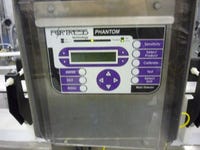 If metal is detected in a product, the Phantom detector will use its air reject system to remove the bottle from the line and not allow it to enter the cooling tunnel where falls of water drop the temperature of the bottles. The cooling system is equipped with Paxton (www.paxtonproducts.com) air-knives, which blow remaining moisture off the bottles.
If metal is detected in a product, the Phantom detector will use its air reject system to remove the bottle from the line and not allow it to enter the cooling tunnel where falls of water drop the temperature of the bottles. The cooling system is equipped with Paxton (www.paxtonproducts.com) air-knives, which blow remaining moisture off the bottles.
A Trine from Accraply (www.accraply.com) roll-fed machine applies wraparound labels, which were designed by Amber Smith & E. Rachael Baird of Tilt Studio, Inc. (www.tiltstudioinc.com) and printed by Orion Labels, LLC, (www.orionlabels.com), to the now cool and dry bottles. Each bottles then is marked using a Linx (www.linxglobal.com) 4600 ink-jet printer, which Kwik Trip was able to salvage from another packaging line.
The coded, labeled bottles move to a Polypack (www.polypack.com) tray-forming and shrinkwrapping system, which forms a holding tray for the bottles. After the bottles are trayed, a sheet of shrink-film is laid on top of the bottles before the complete bundle goes into a heat tunnel for shrinking. An Imaje 2000 Series Print & Apply labeling system Markem-Imaje (www.imaje.com) prints and applies a label to the tray before it is hand-palletized.
Pallets are stretch wrapped by a Lantech (www.lantech.com) turntable machine before they are sent to the Kwik Trip distribution center. The beverages will remain at the distribution center until distribution warehouse employees are directed by the Vocollect (www.vocollect.com) Voice system to pick product for specific store orders.
Ready to partner
The new beverage manufacturing and bottling line was built with enough capacity and flexibility to allow Kwik Trip to run a myriad of products on the line, including drinks made for other companies. The company has a dedicated outside salesperson, who is now charged with building Kwik Trip's copacking business.
Today, the Kwik Trip corporate campus has an excess of 25 acres of land ripe for development. Looking to the future, Kastenschmidt stretches out his arm towards the land and remarks, “In six or seven years, this will be all full of buildings.”
More information is available: |
Fortress Technology Inc., 888/220-8737. www.fortresstechnology.com. |
Regal Packaging Services, Inc., 800/378-1226. www.regalpack.com |
Ball Corp., 303/469-3131 www.ball.com. |
Cannon Equipment, 800/825-8501. www.cannonequipment.com. |
Fogg Co., 616/786-3644. www.foggfiller.com. |
Lantech, 800/866-0322. www.lantech.com. |
Linx Printing Technologies Ltd., 44-01-48-030-2100. www.linxglobal.com. |
Markem-Imaje, 866/263-4644. www.imaje.com. |
New England Machinery, Inc., 941/755-5550. www.neminc.com. |
Orion Labels, LLC, 920/833-1172. www.orionlabels.com |
Paxton, an ITW Air Management brand, 800/441-7475. www.paxtonproducts.com. |
Polypack, Inc., 727/578-5000. www.polypack.com. |
Tilt Studio, Inc., 410/467-4513. tiltstudioinc.com |
Trine labeling, an Accraply brand, 800/423-6539. www.accraply.com. |
Vocollect, Inc., 412/829-8145 . www.vocollect.com. |
W.M. Sprinkman Corp., 800/816-1610. www.sprinkman.com. |
About the Author(s)
You May Also Like
